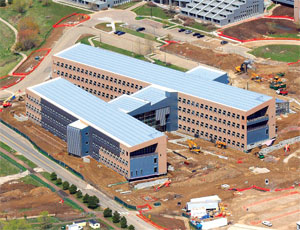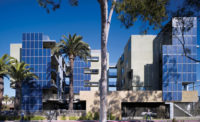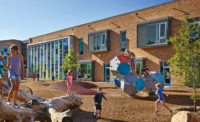Replicable test case in Colorado nears completion on time and within its
$64-million budget
While some are testing the waters of integrated project delivery, a group within the U.S. Dept. of Energy is tilling greener pastures by devising a new design-build project-delivery model for fast-tracked, net-zero-energy buildings, public and private. DOE calls the process progressive, performance-based design-build (DB). Haselden Construction, DOE’s DB contractor for the first application of the model—the $64-million Research Support Facility of the National Renewable Energy Laboratory (NREL) in Golden, Colo.—calls it design-build “on steroids.” The 222,000-sq-ft RSF is the largest known net-zero-energy building in North America, says the DB team.

The new model “will transform the way we look” at producing high-performance buildings in the commercial buildings sector, says Jeffrey M. Baker, director of laboratory operations in the Golden field office of DOE’s Office of Energy Efficiency and Renewable Energy.
The facility is on time to open next month. Haselden and its design team, led by RNL, delivered not only “mission-critical” program elements for the project, they also delivered the owner’s entire wish list—all within the contracted $57.4-million construction cost.
Green DB is a mammoth undertaking for DOE-NREL, which had zero experience with DB or performance-based design. “We had to change our entire culture to accommodate this process,” says Baker. “It’s a huge effort … but we kept at it through painful” internal reviews higher up in the DOE hierarchy, he adds.
Effort aside, Baker calls the process “a massive improvement” over the government’s design-bid-build process.
DOE’s experience with green DB is so positive that it already has initiated five other projects, valued at a total of $262.5 million, using the approach. These endeavors include a second research support facility, two integrated biorefinery research facilities, an energy-systems integration facility and a parking structure. All are located at the Golden campus.
Writing the Book
However, the DOE has set its sights far beyond its own purview. It is determined to spread the model to other government agencies and the private sector with the help of a primer that documents the process. The book is a deliverable in Haselden’s contract.
Already, the U.S. General Services Administration’s Rocky Mountain region is engaged in a partnership with NREL to plan a net-zero-energy building, as yet unfunded, on GSA’s adjacent campus. “If we can pull this off, we will be able to [create a model for GSA] to do this anywhere in the country,” says Susan Damur, GSA’s regional administrator. GSA has not decided on a delivery system, she adds.
To make the green-DB approach work, DOE-NREL needed a bigger-than-usual team for planning and oversight. To get up to speed on DB practices, many on the owner’s team, which totaled 36, underwent a week of training from the Design-Build Institute of America. Northstar Project Management Co., Denver, helped with the procurement.
Baker also spent time selling the idea to those at DOE who provide project oversight. DOE’s document on acquisition of capital assets—the 750-page Order 413 3A—has only one and a half pages on traditional DB.
DOE-NREL also had to convince the DB community it meant business, says Baker. Toward this end, it devised a DB competition that included more communication with the contenders.
Before the request for qualifications went out, the DOE-NREL team started benchmarking and measuring how the building’s projected 800 occupants would use the facility. The team studied everything from plug-in loads and kitchen equipment to computers.
For the DB team, green, performance-based DB has even more pitfalls than ordinary DB. Even getting on the short list was a double-edged sword because of the investment needed for the proposal, which would contain documentation beyond schematic design. “The good news was we got on the short list, and the bad news was we got on the short list,” says Philip Macey, Haselden’s DB project manager.
In return for ownership of its ideas, the team spent at least three times more on its 240-page proposal than the $200,000 stipend DOE offered the losing teams.
The winning team would have an even bigger risk: Under contract terms, if the parties could not come to an agreement, 50% of the design fee stated in the RFP was at risk. The team did not sign its contract or begin receiving compensation until 10 months after the March 2008 award. By that time, 50% of preliminary design was done, says Tom Hootman, director of sustainability for the Denver-based RNL. “We were into it for $2 million, with 50% at risk,” adds Macey, who joined Haselden from RNL several months ago.
Byron Haselden, president of the Denver-based contractor, says the up-front investment and risk makes DB “not for everybody. This project was important for our culture because it is a signature project with societal significance.”
DOE says it is not trying to put anyone out of business but rather create a replicable system. “It’s not all risk—there is reward,” says Shanti Pless, NREL’s research engineer. Pless is referring to an undisclosed seven-figure sum for superior performance. To date, the DB team has received some 90% of the funds.






Post a comment to this article
Report Abusive Comment